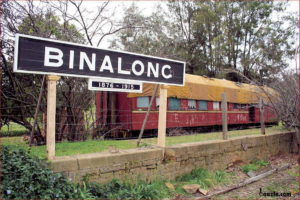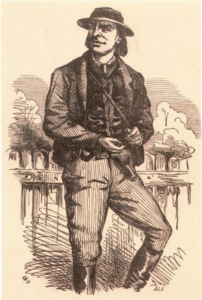This week’s piece on Binalong will kick off a series we will be doing on the history of the many villages that surround the Twin Towns. Before Europeans made it to the region, the Ngunawal and Wiradjuri Aboriginal people occupied the area. They would remain undisturbed until the arrival of Hamilton Hume and his party in 1821. Hume would return three years later with William Hovel, on their journey to Port Philip Bay, however they would pass the Murrumbidgee River further south.
There are multiple theories as to the origin of the name ‘Binalong’. One suggests that it is derived from an Aboriginal word that means ‘under the hills, surrounded by hills, or towards a high place.’ Another suggests it is a corruption of the word ‘Bennelong’, the name of a famous Aboriginal of Sydney Town. As part of Governor Darling’s formal declaration of the legal extent of European settlement in the colony, Binalong was declared illegal to settle in. The 19 counties that the Governor declared legal to inhabit included Boorowa, but swept eastward, cutting Binalong out. However, legal or otherwise, squatters brought flocks of sheep to the area anyway.
The first European settlement in the area was established in 1839, when a police border camp was created. Ever the centre of any town’s social activity, Binalong’s first Pub was built in the form of the Commercial Hotel, in 1842. Built of rammed earth, and closed in 1922, the Hotel was known as Old Paterson’s Pub, after it’s last publican. Two years later, the area had a population of eleven, and by 1847 a permanent police was established, along with a local court. A local businessman used the establishment of legal facilities to obtain a grant from the Commsssioner of Police for the construction of accommodation for the visiting magistrate and witnesses.
Thus the Swan Inn was constructed in close proximity to the original Court House. With the establishment of Cobb and Co in 1853, the Swan Inn entered into an agreement with them, which saw them provide services for coached, drivers and passengers travelling to Lambing Flats. By 1848, the majority of the land surrounding the town had been settled with large grazing leases. 1849 would see the town’s first post office opened, and by 1850, the town was formally surveyed and gazetted, with a prison block established that year. Organised religion reached the town in 1861 with the construction of St Peter & Paul’s Catholic Church on Church Hill.
The first public school was also opened that year. A year later, the town’s local police station opened. Binalong was famously known as a hive of activity for bushrangers, notably Ben Hall and his gang. At 8pm on May 12, 1865, Binalong Police received news that the Woolshed near Murrumburrah had been held-up. Senior Constable Charles Hales suspected that the culprits would head for Binalong, as the family of Bushranger John Dunn, lived in the area. He, along with constables John Bright and Michael King, headed for house of John Dunn’s uncle, John Kelly. They watched the house overnight, but saw no activity. The following morning, an intoxicated John Kelly informed the police that his nephew, along with gang-mate, Johnny Gilbert, were both at his hut.
The police force split into two parties, surrounded the house and watched. The police approached the house, causing dogs to bark and John Kelly to emerge from the hut to see the troopers. Senior Constable Hales entered the hut, and seeing two shadows, ordered his men to surround the hut. However, upon hearing shots from the hut’s rear, he discovered the bushrangers firing at his constables. As the bushrangers took shelter behind a large tree, Johnny Gilbert dropped, whilst Dunn proceeded to run and managed to escape. He would be caught and hung some years later.
Gilbert would be buried in the paddock behind the police station, with his grave now located next to the western approach to Binalong, on the Burley Griffin Way. He was one of Australia’s most prolific criminals at the time of his death, being party to more than 630 hold-ups. The family of poet Banjo Paterson also took up residency in Binalong, in 1869. Paterson attended primary school in the town, but would move to Sydney Grammar in his adolescent years, returning home during breaks. His father is buried in Binalong’s cemetery.
The railway arrived in Binalong in 1876, with the ‘great southern railway,’ passing through the town.
The Amos Brothers were responsible for the extension of the line from Yass to Cootamundra. The original station opened in 1975, and was a simple wooden structure, with the first train arriving in Binalong on Wednesday November 2, 1876.
In April 1883, the original station was destroyed by fire and was replaced by a stone structure that remains as a private residence to this day. That year, the local Court House was completed. The Swan Inn would close following the construction of the railway, unable to compete with hostels and hotels closer to the station. It would reopen a century later as The Black Swan. On April 17, 1915, the Binalong Train Station witnessed a collision between the limited express train from Melbourne, and the Temora mail train. The latter was idled at the platform, when the former collided with it, head-on. 30 passengers were injured, with one taken to Yass hospital, where he would later die.
The coroner would discover that the night officer, upon hearing the Melbourne train approaching, lowered the signals for the wrong line, sending it straight towards the Temora mail train, instead of bypassing it on the loop.
Gilbert The Bushranger.
With the duplication of the line, and creation of diesel engines, the railway had to be realigned further north. And so, in 1916, a new island station was opened, and the old station was decommissioned Binalong continued to grow well into the early 20th Century, with the Mechanics Institute built in 1912, and the old Royal Hotel built that year as well. The Binalong Hotel was built next to the former Commerical Hotel in 1922, and remains the only functioning Pub in town, today. The current Church, St Patrick’s, was built in 1911, following the demolishing of St Peter’s and Paul. The bluestone building was built at a cost of £3,000.


